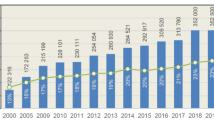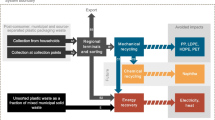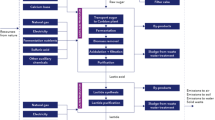Abstract
Purpose
Plastics generate more than 500 tons of waste in Ecuador each year, according to statistics from 2016. Therefore, the Ecuadorian Congress has approved a law to ban single-use plastics to deal with their high volumes contaminating the environment. Furthermore, researchers and policymakers have been concerned about finding possible solutions to replace single-use plastics. Hence, the production of polylactic acid (PLA) in Ecuador and its environmental impact analysis and potential use as the replacement material for petroleum-based polymers is the aim of this study.
Methods
An environmental performance analysis is carried out for the potential production of polylactic acid (PLA) in Guayaquil, Ecuador. For this purpose, the life cycle assessment (LCA) methodology has been used. Therefore, the LCA was considered in three steps: production of PLA, transformation to film product, and end-of-life scenario. The LCA was performed to analyze the potential environmental impact of 1 m2 PLA film production. The International Life Cycle Data System (ILCD) 2011 Midpoint + method, which exists in SimaPro software, was used for the impact analysis.
Results and discussion
The production of biodegradable PLA film causes a climate change impact of 0.85 kg CO2 eq for the established functional unit and several positive environmental impacts. Due to the natural raw material used for its production, the PLA production process significantly contributes to the impacts. The process contribution order was calculated starting with PLA production (74.32%), then electricity (20.41%), polyethylene glycol (PEG) (5.05%), and finally transport (0.21%). An increase in PLA production requires more land, machinery, fuel, and fertilizers. These increases mean higher environmental impacts. PLA production in Ecuador showed a 14% higher climate change indicator than its production in the USA. Optimization of the process could lower the indicator. The landfill scenario was the most pollutant, but recycling shows great promise as the option for end-of-life.
Conclusion
Despite being a bio-solution, all the parameters must be considered when analyzing a shift from plastics to PLA biopolymer. According to the sensitivity analysis, the production of PLA and its film product system had a good consistency when parameters like the amount of sugar needed is varied. According to the environmental score obtained, PLA production from sugar cane is the best option in its production in Ecuador.











Similar content being viewed by others
Data availability
All data generated or analyzed during this study are included in this published article (and its supplementary information files).
References
Asamblea Nacional del Ecuador (2019a) Informe para Primer Debate ley plasticos. https://mingasporelmar.org/wp-content/uploads/2019a/11/INFORME_PRIMER_DEBATE_LEY_PLASTICOS_entregado.pdf
Asamblea Nacional del Ecuador (2019b) Listo Informe De Proyecto Que Plantea Eliminar El Plástico e Un Solo Uso. In: https://www.asambleanacional.gob.ec/es/noticia/63890-listo-informe-de-proyecto-que-plantea-eliminar-el. https://www.asambleanacional.gob.ec/es/noticia/63890-listo-informe-de-proyecto-que-plantea-eliminar-el. Accessed 8 Feb 2022
Asamblea Nacional del Ecuador (2021) Ley Orgánica de Economía Circular Inclusiva. Quito
Baumann H, Tillman A-M (2004) The Hitch Hiker’s Guide to LCA
Benini L, Sala S (2016) Uncertainty and sensitivity analysis of normalization factors to methodological assumptions. Int J Life Cycle Assess 21:224–236. https://doi.org/10.1007/s11367-015-1013-5
Brendan B (2018) Tackling plastic pollution in the Galápagos. In: https://www.worldwildlife.org/stories/tackling-plastic-pollution-in-the-galapagos. https://www.wwf.org.ec/?343790/plasticoGalapagos
Burneo D, Cansino JM, Yñiguez R (2020) Environmental and socioeconomic impacts of urban waste recycling as part of circular economy. The case of cuenca (Ecuador). Sustainability 12. https://doi.org/10.3390/SU12083406
Chitaka TY, Russo V, von Blottnitz H (2020) In pursuit of environmentally friendly straws: a comparative life cycle assessment of five straw material options in South Africa. Int J Life Cycle Assess 25:1818–1832. https://doi.org/10.1007/s11367-020-01786-w
Choi B, Yoo S, Park S (2018) Carbon Footprint of packaging films made from LDPE, PLA, and PLA/PBAT blends in South Korea. Sustainability 10:2369. https://doi.org/10.3390/su10072369
Cole M, Lindeque P, Halsband C, Galloway TS (2011) Microplastics as contaminants in the marine environment: a review. Mar Pollut Bull 62:2588–2597
Cosate de Andrade MF, Souza PMS, Cavalett O, Morales AR (2016) Life Cycle Assessment of Poly(Lactic Acid) (PLA): Comparison Between Chemical Recycling, Mechanical Recycling and Composting. J Polym Environ 24:372–384. https://doi.org/10.1007/s10924-016-0787-2
Dong YH, Ng ST (2014) Comparing the midpoint and endpoint approaches based on ReCiPe—a study of commercial buildings in Hong Kong. Int J Life Cycle Assess 19:1409–1423. https://doi.org/10.1007/s11367-014-0743-0
Dunn MG, Bellincampi LD, Tria AJ, Zawadsky JP (1997) Preliminary development of a collagen-PLA composite for ACL reconstruction. J Appl Polym Sci 63:1423–1428. https://doi.org/10.1002/(SICI)1097-4628(19970314)63:11%3c1423::AID-APP4%3e3.3.CO;2-8
European Commission -- Joint Research Centre -- Institute for Environment and Sustainability (2010) International Reference Life Cycle Data System (ILCD) Handbook -- General guide for Life Cycle Assessment -- Detailed guidance
Goedkoop M, Heijungs R, Huijbregts M et al (2009) ReCiPe 2008
Groot WJ, Borén T (2010) Life cycle assessment of the manufacture of lactide and PLA biopolymers from sugarcane in Thailand. Int J Life Cycle Assess 15:970–984. https://doi.org/10.1007/s11367-010-0225-y
Gui Z, Xu Y, Gao Y et al (2012) Novel polyethylene glycol-based polyester-toughened polylactide. Mater Lett 71:63–65. https://doi.org/10.1016/j.matlet.2011.12.045
Günkaya Z, Banar M (2016) An environmental comparison of biocomposite film based on orange peel-derived pectin jelly-corn starch and LDPE film: LCA and biodegradability. Int J Life Cycle Assess 21:465–475. https://doi.org/10.1007/s11367-016-1042-8
Gupta B, Revagade N, Hilborn J (2007) Poly(lactic acid) fiber: an overview. Prog Polym Sci 32:455–482. https://doi.org/10.1016/j.progpolymsci.2007.01.005
Han JH (2014) A Review of food packaging technologies and innovations. In: Innovations in Food Packaging. Elsevier, pp 3–12
Holland Circular Hotspot (2021) Waste Management Country Report: Ecuador
Hosseini SN, Pirsa S, Farzi J (2021) Biodegradable nano composite film based on modified starch-albumin/MgO; antibacterial, antioxidant and structural properties. Polym Test 97:107182. https://doi.org/10.1016/j.polymertesting.2021.107182
Hottle TA, Bilec MM, Landis AE (2017) Biopolymer production and end of life comparisons using life cycle assessment. Resour Conserv Recycl 122:295–306. https://doi.org/10.1016/j.resconrec.2017.03.002
Hou P, Xu Y, Taiebat M et al (2018) Life cycle assessment of end-of-life treatments for plastic film waste. J Clean Prod 201:1052–1060. https://doi.org/10.1016/j.jclepro.2018.07.278
Huang Y, Spray A, Parry T (2013) Sensitivity analysis of methodological choices in road pavement LCA. Int J Life Cycle Assess 18:93–101. https://doi.org/10.1007/s11367-012-0450-7
Huijbregts MAJ, Steinmann ZJN, Elshout PMF et al (2017) ReCiPe2016: a harmonised life cycle impact assessment method at midpoint and endpoint level. Int J Life Cycle Assess 22:138–147. https://doi.org/10.1007/s11367-016-1246-y
Instituto Nacional de Estadística y Censos (INEC) (2021) Estadística de Información Ambiental Económica en Gobiernos Autónomos Descentralizados Municipales - Gestión de Residuos Sólidos 2020
Jabraili A, Pirsa S, Pirouzifard MK, Amiri S (2021) Biodegradable nanocomposite film based on gluten/silica/calcium chloride: physicochemical properties and bioactive compounds extraction capacity. J Polym Environ 29:2557–2571. https://doi.org/10.1007/S10924-021-02050-4/FIGURES/7
Jamshidian M, Tehrany EA, Imran M et al (2010) Poly-lactic acid: production, applications, nanocomposites, and release studies. Compr Rev Food Sci Food Saf 9:552–571. https://doi.org/10.1111/j.1541-4337.2010.00126.x
Juodeikiene G, Vidmantiene D, Basinskiene L et al (2015) Green metrics for sustainability of biobased lactic acid from starchy biomass vs chemical synthesis. Catal Today 239:11–16. https://doi.org/10.1016/j.cattod.2014.05.039
Khan F, Raveender V, Husain T (2002) Effective environmental management through life cycle assessment. J Loss Prev Process Ind 15:455–466. https://doi.org/10.1016/S0950-4230(02)00051-7
Lasprilla AJR, Martinez GAR, Lunelli BH et al (2012) Poly-lactic acid synthesis for application in biomedical devices — a review. Biotechnol Adv 30:321–328. https://doi.org/10.1016/j.biotechadv.2011.06.019
Li C, Gao M, Zhu W et al (2021) Recent advances in the separation and purification of lactic acid from fermentation broth. Process Biochem 104:142–151. https://doi.org/10.1016/j.procbio.2021.03.011
Li J, Lu XL, Zheng YF (2008) Effect of surface modified hydroxyapatite on the tensile property improvement of HA/PLA composite. Appl Surf Sci 255:494–497. https://doi.org/10.1016/j.apsusc.2008.06.067
Li X, Chu C, Wei Y et al (2017) In vitro degradation kinetics of pure PLA and Mg/PLA composite: effects of immersion temperature and compression stress. Acta Biomater 48:468–478. https://doi.org/10.1016/j.actbio.2016.11.001
Liao SS, Cui FZ, Zhang W, Feng QL (2004) Hierarchically biomimetic bone scaffold materials: nano-HA/collagen/PLA composite. J Biomed Mater Res - Part B Appl Biomater 69:158–165. https://doi.org/10.1002/jbm.b.20035
Lunt J (1998) Large-scale production, properties and commercial applications of polylactic acid polymers. Polym Degrad Stab 59:145–152. https://doi.org/10.1016/S0141-3910(97)00148-1
Madival S, Auras R, Singh SP, Narayan R (2009) Assessment of the environmental profile of PLA, PET and PS clamshell containers using LCA methodology. J Clean Prod 17:1183–1194. https://doi.org/10.1016/j.jclepro.2009.03.015
Mahalle L, Alemdar A, Mihai M, Legros N (2014) A cradle-to-gate life cycle assessment of wood fibre-reinforced polylactic acid (PLA) and polylactic acid/thermoplastic starch (PLA/TPS) biocomposites. Int J Life Cycle Assess 19:1305–1315. https://doi.org/10.1007/s11367-014-0731-4
Marsh K, Bugusu B (2007) Food packaging - Roles, materials, and environmental issues: Scientific status summary. J Food Sci 72.https://doi.org/10.1111/j.1750-3841.2007.00301.x
McKeown P, Jones MD (2020) The Chemical Recycling of PLA: A Review. Sustain Chem 1:1–22. https://doi.org/10.3390/suschem1010001
Meydanju N, Pirsa S, Farzi J (2022) Biodegradable film based on lemon peel powder containing xanthan gum and TiO2–Ag nanoparticles: Investigation of physicochemical and antibacterial properties. Polym Test 106:107445. https://doi.org/10.1016/j.polymertesting.2021.107445
Ministerio del Ambiente A y TE Precios de Mercado Referenciales para Materiales Reciclables. https://www.ambiente.gob.ec/precios-de-mercado-referenciales-para-materiales-reciclables/. Accessed 20 Jul 2021
Morão A, de Bie F (2019) Life Cycle impact assessment of polylactic acid (PLA) produced from sugarcane in Thailand. J Polym Environ 27:2523–2539. https://doi.org/10.1007/s10924-019-01525-9
Muñoz I, Flury K, Jungbluth N et al (2014) Life cycle assessment of bio-based ethanol produced from different agricultural feedstocks. Int J Life Cycle Assess 19:109–119. https://doi.org/10.1007/s11367-013-0613-1
Piccinno F, Hischier R, Seeger S, Som C (2015) Life cycle assessment of a new technology to extract, functionalize and orient cellulose nanofibers from food waste. ACS Sustain Chem Eng 3:1047–1055. https://doi.org/10.1021/acssuschemeng.5b00209
Pirsa S, Aghbolagh Sharifi K (2020) A review of the applications of bioproteins in the preparation of biodegradable films and polymers. J Chem Lett 1:47–58. https://doi.org/10.22034/JCHEMLETT.2020.111200
Pirsa S, Asadi S (2021) Innovative smart and biodegradable packaging for margarine based on a nano composite polylactic acid/lycopene film. Food Addit Contam - Part A Chem Anal Control Expo Risk Assess 38:856–869. https://doi.org/10.1080/19440049.2021.1891299
Pirsa S, Farshchi E, Roufegarinejad L (2020) Antioxidant/antimicrobial film based on carboxymethyl cellulose/gelatin/TiO2–Ag nano-composite. J Polym Environ 28:3154–3163. https://doi.org/10.1007/S10924-020-01846-0
Pirsa S, Mohammadi B (2021) Conducting/biodegradable chitosan-polyaniline film; antioxidant, color, solubility and water vapor permeability properties. Main Gr Chem 20:133–147. https://doi.org/10.3233/MGC-210007
Pivsa-Art W, Fujii K, Nomura K et al (2016) The effect of poly(ethylene glycol) as plasticizer in blends of poly(lactic acid) and poly(butylene succinate). J Appl Polym Sci 133:n/a-n/a. https://doi.org/10.1002/app.43044
Pré-Sustainability B.V. (2019) SimaPro 9.2
Pré-Sustaintability B.V. (2019) SimaPro 9.0. https://simapro.com/
Pretula J, Slomkowski S, Penczek S (2016) Polylactides—Methods of synthesis and characterization. Adv Drug Deliv Rev 107:3–16. https://doi.org/10.1016/j.addr.2016.05.002
Ramirez AD, Boero A, Rivela B et al (2020) Life cycle methods to analyze the environmental sustainability of electricity generation in Ecuador: is decarbonization the right path? Renew Sustain Energy Rev 134:110373. https://doi.org/10.1016/j.rser.2020.110373
Restuccia D, Spizzirri UG, Parisi OI et al (2010) New EU regulation aspects and global market of active and intelligent packaging for food industry applications. Food Control 21:1425–1435
Riofrio A, Alcivar T, Baykara H (2021) Environmental and economic viability of chitosan production in Guayas-Ecuador: a robust investment and life cycle analysis. ACS Omega 6:23038–23051. https://doi.org/10.1021/acsomega.1c01672
Servicio Ecuatoriano de Normalización (INEN) (2012) Disposición De Desechos Plásticos Post-Consumo. Requisitos-2634
Sharifi KA, Pirsa S (2021) Biodegradable film of black mulberry pulp pectin/chlorophyll of black mulberry leaf encapsulated with carboxymethylcellulose/silica nanoparticles: Investigation of physicochemical and antimicrobial properties. Mater Chem Phys 267:124580. https://doi.org/10.1016/j.matchemphys.2021.124580
Soam S, Kumar R, Gupta RP et al (2015) Life cycle assessment of fuel ethanol from sugarcane molasses innorthern and western India and its impact on Indian biofuel programme. Energy 83:307–315. https://doi.org/10.1016/j.energy.2015.02.025
Statista Polyethylene terephthalate prices globally (2022) In: Statista. https://www.statista.com/statistics/1171088/price-polyethylene-terephthalate-forecast-globally/. Accessed 20 Jul 2021
Tanase CE, Spiridon I (2014) PLA/chitosan/keratin composites for biomedical applications. Mater Sci Eng C 40:242–247. https://doi.org/10.1016/j.msec.2014.03.054
The International Standards Organisation (2006a) Environmental management — life cycle assessment — principles and framework (Standard No. 14040)
The International Standards Organisation (2006b) Environmental management — life cycle assessment — requirements and guidelines (Standard No. 14044)
Tsiropoulos I, Faaij APC, Seabra JEA et al (2014) Life cycle assessment of sugarcane ethanol production in India in comparison to Brazil. Int J Life Cycle Assess 19:1049–1067. https://doi.org/10.1007/s11367-014-0714-5
United Nations (2018) Latin America and the Caribbean bids good-bye to plastic bags. https://www.unep.org/news-and-stories/story/latin-america-and-caribbean-bids-good-bye-plastic-bags. Accessed 15 Sep 2021
van Paassen M, Braconi N, Kuling L et al (2019) Agri-footprint 5.0: Part 1: Methodology and basic principles
Vink ETH, Davies S (2015) Life cycle inventory and impact assessment data for 2014 Ingeo® Polylactide Production. Ind Biotechnol 11:167–180. https://doi.org/10.1089/ind.2015.0003
Vink ETH, Rábago KR, Glassner DA, Gruber PR (2003) Applications of life cycle assessment to NatureWorks™ polylactide (PLA) production. Polym Degrad Stab 80:403–419. https://doi.org/10.1016/S0141-3910(02)00372-5
Wei W, Larrey-Lassalle P, Faure T et al (2015) How to conduct a proper sensitivity analysis in life cycle assessment: Taking into account correlations within LCI data and interactions within the LCA calculation model. Environ Sci Technol 49:377–385. https://doi.org/10.1021/es502128k
Wernet G, Bauer C, Steubing B et al (2016) The ecoinvent database version 3 (part I): overview and methodology. Int J Life Cycle Assess 21:1218–1230. https://doi.org/10.1007/S11367-016-1087-8/FIGURES/7
Wright SL, Thompson RC, Galloway TS (2013) The physical impacts of microplastics on marine organisms: A review. Environ Pollut 178:483–492. https://doi.org/10.1016/j.envpol.2013.02.031
Yorghanlu RA, Hemmati H, Pirsa S, Makhani A (2021) Production of biodegradable sodium caseinate film containing titanium oxide nanoparticles and grape seed essence and investigation of physicochemical properties. Polym Bull. https://doi.org/10.1007/s00289-021-03900-w
Acknowledgements
We would like to express our most profound appreciation to the Pré Sustainability team for giving us the opportunity and permission to use the SimaPro software. We would like to thank the reviewers and the editor for the valuable comments provided that led to the manuscript’s improvement.
Author information
Authors and Affiliations
Corresponding author
Ethics declarations
Conflict of interest
The authors declare no competing interest.
Additional information
Communicated by Sonia Valdivia.
Publisher's note
Springer Nature remains neutral with regard to jurisdictional claims in published maps and institutional affiliations.
Supplementary information
Below is the link to the electronic supplementary material.
Rights and permissions
About this article
Cite this article
Riofrio, A., Cornejo, M. & Baykara, H. Life cycle and environmental impact evaluation of polylactic acid (PLA) production in Ecuador. Int J Life Cycle Assess 27, 834–848 (2022). https://doi.org/10.1007/s11367-022-02067-4
Received:
Accepted:
Published:
Issue Date:
DOI: https://doi.org/10.1007/s11367-022-02067-4




